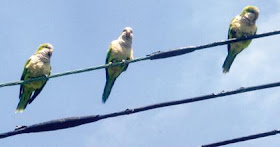Just as humans name their babies, quaker parrots name their babies as well.
A national geographic team has conducted an experiment to prove this.
In the experiment scientists set up 17 quaker parrot nests and attached microphones to them to record their calls.
The scientists found that in each nest the mother names their children before they could even make a sound.
Each baby had its own unique name and learned to respond to it after several weeks.
Each child would mimic its own name just like a human child learns by repeating words it learns.
Scientists also found out that each mother named her children a name similar to her own.
The names and variations of the names are passed down through generations of children.
Why?
It is currently unknown why quaker parrots name their children, but scientists have some very good guesses.
Most likely the names help their mother find their chicks when flying long distances to communal foraging sites.
Quaker parrot mothers need to keep track of their children for a relatively long time compared to other animals, until the quaker parrot babies can become independent.
Here is a national geographic video to go along with the article.


























